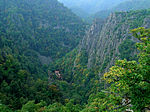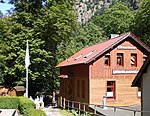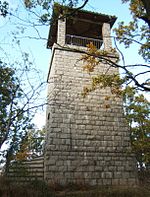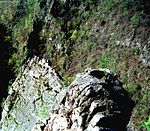Walpurgis Hall
Buildings and structures in the HarzCultural infrastructure completed in 1901German building and structure stubsGoethe's FaustMuseums in Saxony-Anhalt ... and 1 more
Walpurgis Night

The Walpurgis Hall (German: Walpurgishalle) is a hall on the Witches' Dance Floor near Thale in the Harz mountains, Germany, built in the Old Germanic style by Hermann Hendrich and Bernhard Sehring. The hall was opened in 1901 and is a museum today. Whilst Sehring designed the architecture of the building to Hendrich's guidelines, Hendrich himself was responsible for the five large paintings in the interior of the hall. These portray scenes of the Walpurgis Night from Goethe's Faust known as the: Will-o'-the-Wisp Dance, Mammon's Cave, Witches' Dance, Bride of the Wind und Gretchen's Appearance (Gretchen's Tragedy).
Excerpt from the Wikipedia article Walpurgis Hall (License: CC BY-SA 3.0, Authors, Images).Walpurgis Hall
Hexentanzplatz,
Geographical coordinates (GPS) Address Nearby Places Show on map
Geographical coordinates (GPS)
| Latitude | Longitude |
|---|---|
| N 51.732722222222 ° | E 11.026083333333 ° |
Address
Teufelsgrill
Hexentanzplatz
06502 (Thale)
Saxony-Anhalt, Germany
Open on Google Maps








